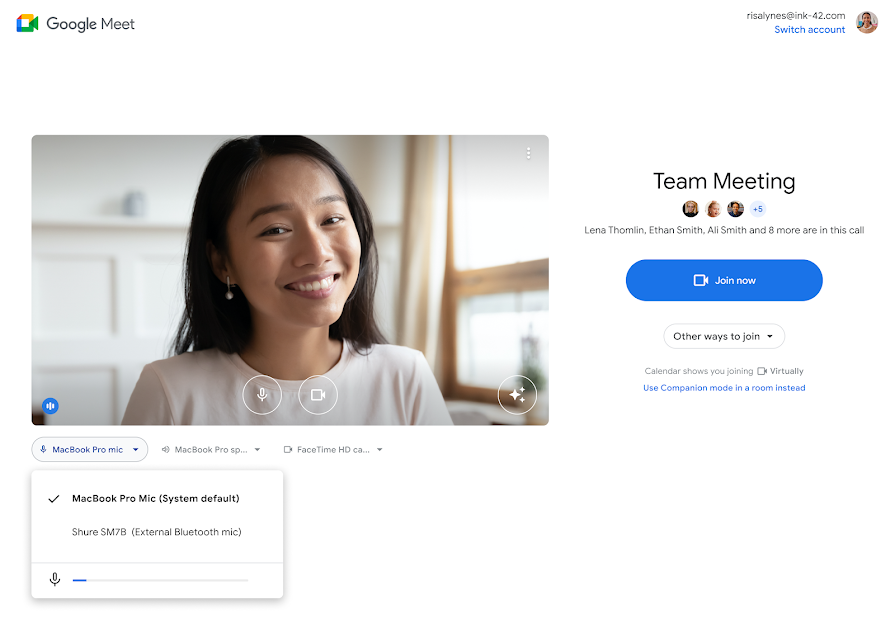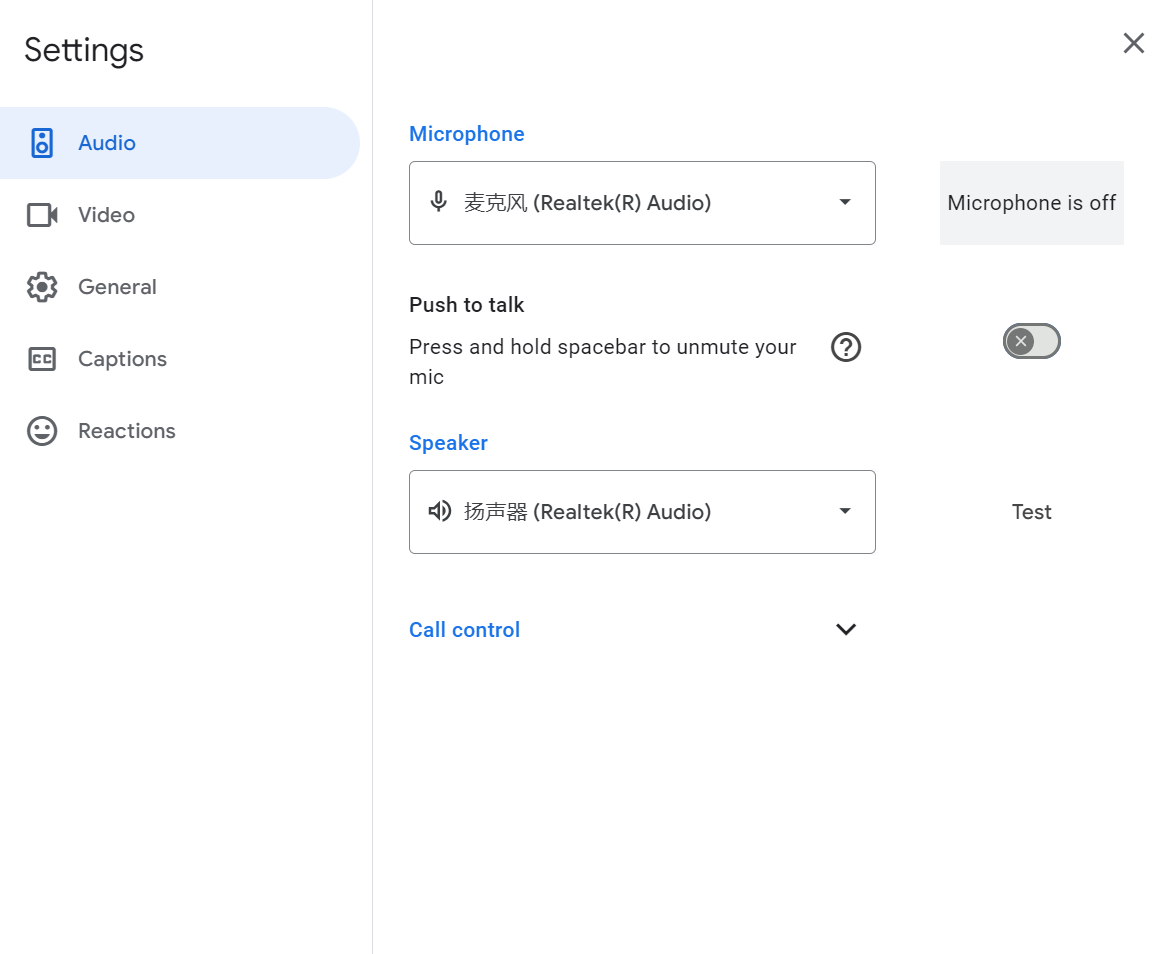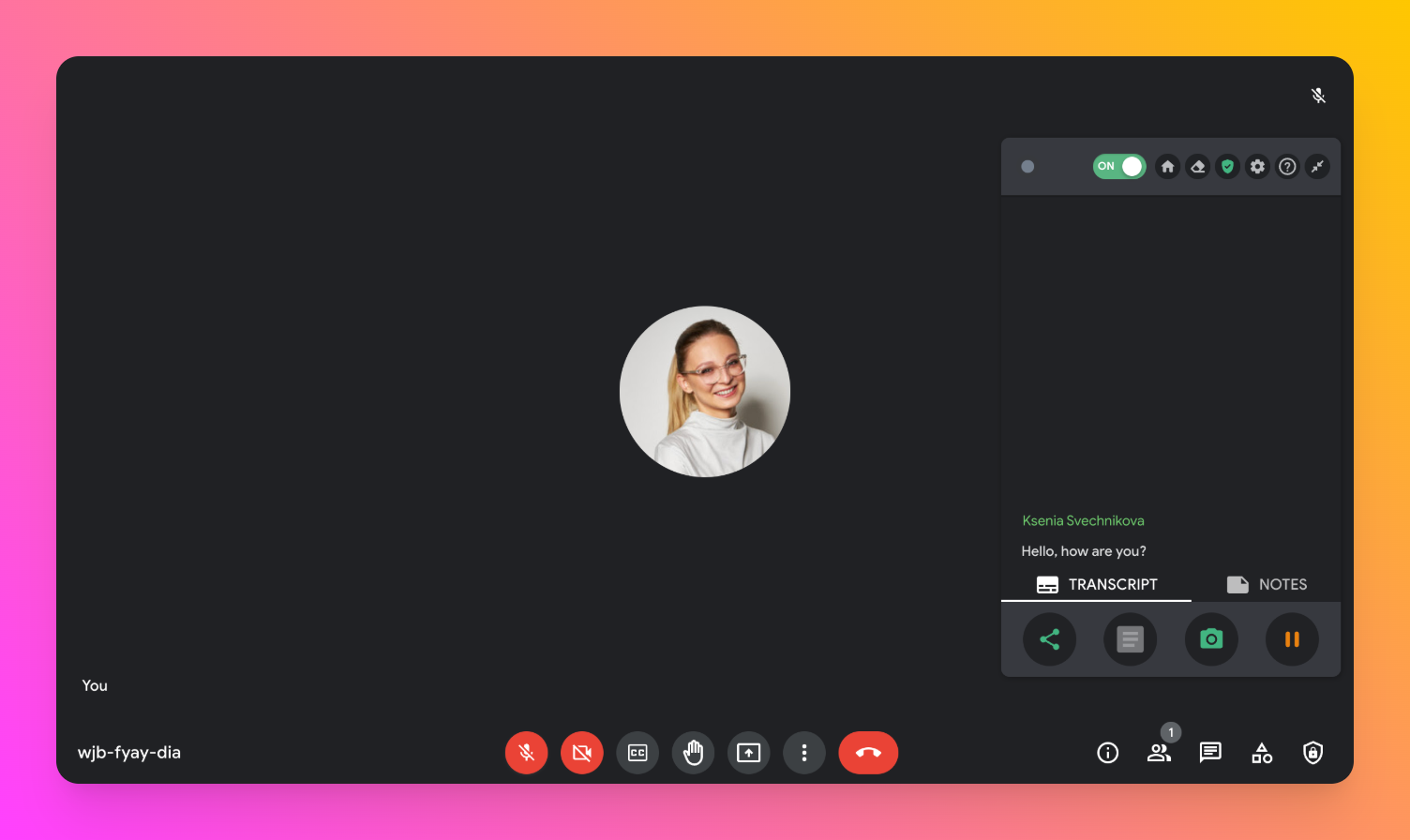Fix Google Meet Echo Issues Easily
July 23, 2024
July 23, 2024
June 12, 2025
June 12, 2025
Echo in Google Meet can disrupt your virtual meetings, making it hard to communicate effectively. You may have heard your voice bounce back or someone else's voice loop during a call. This issue can be confusing and frustrating, but understanding the causes can help you solve it.
This article will cover the causes of echo in Google Meet, its impact on user experience, practical solutions to eliminate it, and how to configure your settings effectively.
Understanding Echo in Video Calls

Echo occurs when sound from your speakers is picked up by your microphone and played back into the call. This creates a loop that repeats the audio. Common causes include:
- Speaker and Microphone Proximity: When your speakers are too close to your microphone, the sound from the speakers feeds back.
- Multiple Devices: If you join a meeting from multiple devices in the same room, they can pick up each other's audio.
- Room Acoustics: Hard surfaces like walls and floors can reflect sound, causing echo.
How Echo Affects User Experience
Echo can make it hard to understand what others are saying, leading to miscommunication. It can also be distracting and annoying, reducing the overall quality of the meeting. For example, if you're presenting and your voice echoes, it may cause confusion and disrupt the flow of your presentation.
Examples of Echo Issues in Google Meet
- Feedback Loop: A participant's microphone picks up the sound from their speakers, creating a feedback loop.
- Delayed Echo: Audio delays cause your voice to echo back a few seconds after you speak.
- Multiple Participants: When several people in the same room join the call on different devices, echoes multiply.
Why Does Echo Occur in Google Meet?
Echo in Google Meet can come from various sources. Identifying these causes can help you take the right steps to eliminate the problem.
Hardware Placement Issues:
- Speaker and Microphone Proximity: When speakers are too close to the microphone, the sound from the speakers can be picked up by the microphone, creating a feedback loop.
- Device Positioning: If your microphone is placed near reflective surfaces like walls or desks, it can capture echoes. Adjusting the placement of your devices can minimize this effect.
Misconfiguration of Audio Settings:

Image from Google
- Incorrect Device Selection: Sometimes, selecting the wrong audio input or output device in Google Meet settings can cause echo. Ensure that you choose the correct microphone and speaker for your setup.
- Volume Levels: High volume levels can cause the microphone to pick up sound from the speakers. Lowering the volume can reduce the chance of echo.
Feedback from Speakers and Microphones:
- Open Microphones: If multiple people in the same room have their microphones on, the sound from one speaker can be picked up by another microphone, causing echo.
- Speaker Quality: Low-quality speakers may distort sound, making it more likely to be picked up by the microphone. Using high-quality audio equipment can help reduce this issue.
Effects of Room Acoustics on Echo:
- Reflective Surfaces: Rooms with hard surfaces like tiles, glass, or hardwood floors can reflect sound, leading to echo. Adding soft furnishings like carpets, curtains, or acoustic panels can absorb sound and reduce echo.
- Room Size and Shape: Large, empty rooms or rooms with irregular shapes can also contribute to echo. Smaller, well-furnished rooms tend to have better acoustics.
How to Stop Echo on Google Meet?
Stopping echo on Google Meet involves several practical steps. Each solution targets different aspects of the audio setup to ensure clear communication.
1. Lowering Speaker Volume to Reduce Feedback:
- Immediate Effect: Reducing the volume of your speakers can prevent the microphone from picking up the sound, which is a common cause of echo.
- How to Adjust: Go into your device's sound settings or use the volume controls on your speakers to find a balanced level where you can hear clearly without causing feedback.
- Pro Tip: Test different volume levels while speaking into the microphone to find the optimal setting.
2. Using Headphones to Isolate Audio:
- Eliminate Feedback Loops: Headphones keep the audio confined to your ears, preventing the microphone from picking up sound from the speakers.
- Types of Headphones: Over-ear and in-ear headphones both work well. Choose a pair with a built-in microphone for added convenience.
- Benefits: This method not only stops echo but also improves overall audio quality, making the conversation clearer for all participants.
3. Adjusting Microphone Sensitivity Settings:
- Fine-Tuning: Lowering the microphone sensitivity can prevent it from picking up background noise and echoes.
- How to Adjust: Access your computer’s sound settings or the microphone settings in Google Meet. Reduce the sensitivity or gain until the echo is minimized.
- Testing: Speak at different volumes to ensure the microphone still picks up your voice clearly without capturing unwanted sounds.
4. Placing Microphones Away from Reflective Surfaces:
- Understanding Reflections: Reflective surfaces like walls, desks, and windows can bounce sound back into the microphone, causing an echo.
- Optimal Placement: Place your microphone where it is less likely to pick up these reflections. For instance, use a microphone stand or move it closer to the sound source (your mouth).
- Soft Furnishings: Adding rugs, curtains, and cushions around your workspace can absorb sound and reduce reflections.
How to Configure Google Meet Settings to Prevent Echo
Properly configuring your Google Meet settings can make a big difference in preventing echo. Here’s how you can optimize these settings.
1. Accessing the Audio Settings in Google Meet:

- Step-by-Step Access: During a Google Meet session, click on the three vertical dots in the bottom right corner of your screen. Select "Settings" from the menu.
- Navigate to Audio Settings: Inside the settings menu, click on the "Audio" tab. Here, you can make adjustments to both your microphone and speaker settings.
- Quick Adjustments: Ensure you have selected the correct microphone and speaker from the dropdown menus. This is essential if you are using external audio devices.
2. Enabling Noise Cancellation Feature:
- Locate the Option: Within the audio settings, look for the noise cancellation toggle. This feature helps filter out background noise and can reduce echo.
- Turn it On: Simply toggle the switch to enable noise cancellation. Google Meet uses AI to suppress background sounds, making your voice clearer.
- Effectiveness: While not a complete solution for echo, this feature significantly improves audio quality and can reduce minor echoes.
3. Configuring Speaker and Microphone Settings:
- Microphone Level: Adjust the microphone input level so it does not pick up ambient sounds. Lowering the input level can prevent it from picking up audio from your speakers.
- Speaker Volume: Ensure the speaker volume is set to a level that is easy to hear without being too loud. Overly high volume can cause feedback loops.
- Advanced Settings: Some devices offer advanced audio settings like echo cancellation and noise suppression in their audio drivers. Access these settings via your computer’s control panel or sound settings.
4. Testing Audio Before Meetings to Identify Issues:
- Pre-Meeting Test: Always test your audio before joining a meeting. In Google Meet, you can do this by clicking the "Test" button in the audio settings.
- Listen for Echo: Speak into your microphone and listen for any echo. If you hear feedback, adjust your settings accordingly.
- Troubleshoot: If issues persist, consider switching to different audio devices or adjusting your environment to minimize reflective surfaces and background noise.
What to Do if You Still Experience Echo?
Sometimes, even after optimizing your settings, you may still encounter echo issues in Google Meet. Here’s what you can do to address these persistent problems.
1. Checking for Software Updates and Patches:

- Keep Software Up-to-Date: Ensure Google Meet and your operating system are running the latest versions. Updates often contain fixes for known issues, including audio problems.
- Browser Updates: If you use Google Meet on a browser, make sure the browser itself is updated. Chrome, Firefox, and other browsers frequently release patches that improve performance and compatibility.
- Automatic Updates: Enable automatic updates for your software and apps to ensure you always have the latest fixes and improvements.
2. Ensuring No Background Apps Interfere with Audio:
- Close Unnecessary Applications: Background apps can conflict with Google Meet, causing audio issues. Close any applications that you do not need during the meeting.
- Check Task Manager: On Windows, use Task Manager to see which applications are using your microphone and speakers. On Mac, use Activity Monitor for the same purpose.
- Disable Background Processes: Some background processes, such as voice assistants or other communication apps, might interfere with Google Meet. Disable them temporarily during your meeting.
3. Using External Audio Devices for Better Control:
- High-Quality Headphones and Microphones: Invest in good-quality external headphones and microphones that offer noise cancellation and echo reduction features.
- USB Devices: Use USB-connected audio devices instead of built-in laptop microphones and speakers. USB devices typically provide better audio quality and less interference.
- Bluetooth Devices: If using Bluetooth audio devices, ensure they are fully charged and properly paired. Low battery or poor connection can cause audio issues.
4. Seeking Professional IT Support if Needed:
- Company IT Support: If you are in a professional setting, reach out to your company’s IT support team. They can provide specialized help and might have specific solutions suited to your organization’s setup.
- Google Support: Utilize Google’s support services. You can find troubleshooting guides and contact options on the Google Meet Help Center.
- Third-Party Experts: Consider consulting with third-party IT experts who specialize in video conferencing tools. They can offer tailored solutions and advanced troubleshooting steps.
{{rt_cta_ai-convenience}}
How Tactiq Helps Prevent Echo Issues in Google Meet

Tactiq offers a range of features designed to enhance your Google Meet experience. Here’s how Tactiq can help:
1. Enhanced Productivity with Automated Features:
- No Manual Effort: Tactiq automates many tasks that you would otherwise have to do manually, such as note-taking and transcription. This means you can focus more on the meeting itself rather than being distracted by administrative tasks.
- Consistent Documentation: Since Tactiq handles documentation automatically, the records are consistent and reliable. No more missing key points or forgetting to write down important information.
- Time-Saving: Automation significantly reduces the time you spend on post-meeting tasks. You get all the necessary information without having to go back and review the entire meeting.
2. Reliable Transcription and Note Management:
- Accuracy: Tactiq’s transcription services are highly accurate, capturing every word spoken during the meeting. This ensures that you have a complete and precise record of what was discussed.
- Searchable Notes: Transcriptions and notes are searchable, making it easy to find specific information quickly. This is especially useful for reviewing past meetings or preparing for follow-up sessions.
- Centralized Storage: All notes and transcriptions are stored in one place, which simplifies management and retrieval. You can access your meeting records anytime, from anywhere.
3. User-Friendly Interface and Easy Installation:
- Intuitive Design: Tactiq is designed to be user-friendly, with an interface that is easy to navigate. This ensures that you can use the tool effectively, even if you’re not particularly tech-savvy.
- Quick Setup: Installation is straightforward and quick, allowing you to start using Tactiq almost immediately. There’s no need for extensive configuration or a steep learning curve.
- Compatibility: Tactiq works seamlessly with Google Meet, meaning you don’t have to worry about compatibility issues. It integrates smoothly, adding its features to your existing setup.

Choosing Tactiq for your Google Meet needs ensures a more productive, efficient, and enjoyable meeting experience.
Ensuring Clear Communication in Google Meet
Understanding and addressing echo issues in Google Meet can significantly enhance your virtual meeting experience. By identifying common causes, optimizing your audio setup, and leveraging tools like Tactiq, you can ensure clear communication and productive discussions. Implement these practical solutions and configurations to minimize disruptions and enjoy smoother, more effective meetings.
Echo happens when your microphone picks up sound from your speakers or from other devices in the same room, creating a feedback loop. This disrupts communication, making it hard to understand others and can distract or confuse participants, especially during presentations.
Lower your speaker volume, use headphones, and adjust your microphone sensitivity to prevent sound from looping back into the call. These steps help you maintain clear audio so everyone can focus on the discussion without distractions.
Access the audio settings in Google Meet, select the correct microphone and speaker, enable noise cancellation, and test your audio before meetings. Proper configuration ensures your voice is clear and reduces the risk of echo, so you can communicate confidently.
Update your software and browser, close unnecessary background apps, use high-quality external audio devices, and seek IT support if needed. These actions help you resolve stubborn echo problems and keep your meetings running smoothly.
Tactiq automates note-taking and transcription, letting you focus on the meeting instead of troubleshooting audio. With accurate, searchable records and seamless integration, you save time and ensure nothing important gets lost—even if audio issues occur.
Want the convenience of AI summaries?
Try Tactiq for your upcoming meeting.
Want the convenience of AI summaries?
Try Tactiq for your upcoming meeting.
Want the convenience of AI summaries?
Try Tactiq for your upcoming meeting.


_Main.jpg)






